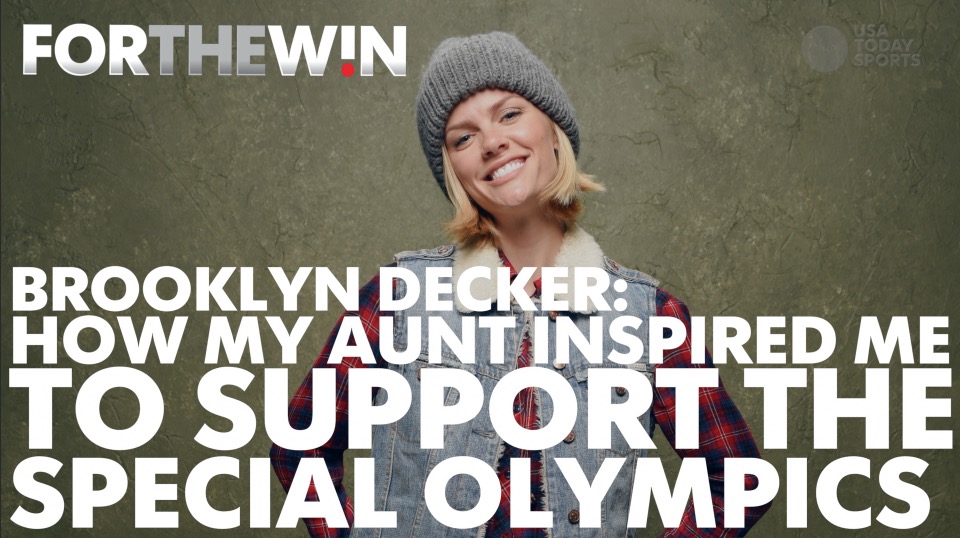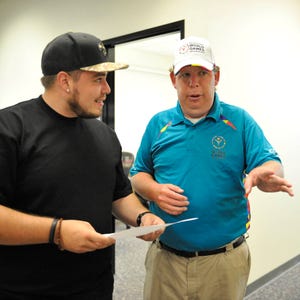Special Olympics evolve with different approach to competition – USA TODAY
LOS ANGELES — A top player on Kenya’s beach volleyball team here at the Special Olympics has no intellectual disability, yet he helped lead Kenya into the medal round this week at the World Games. He played volleyball in high school, expects to play in college and his mother, manager of Kenya’s Special Olympics program, added him to the team roster.
It is not a scandal.
Is is part of Unified Sports, a program gaining popularity not only in the Special Olympics but across the special-needs community. Athletes who have intellectual disabilities compete with Unified partners, athletes who don’t have disabilities. The idea sounded absurd to Kenyan volleyball player Victor Masila last year when his mother, Susan, asked him to participate because she was struggling to recruit Unified partners for Kenya’s new team.
“I was thinking of excuses not to do it,” Victor said at the Special Olympics beach volleyball venue in nearby Long Beach.
In December, Masila, 19, met Joseph Njunie, 16, the special-needs teammate with whom he’d be working, and he tossed Njunie the volleyball.
Njunie kicked it back.
Masila tossed the ball again.
Njunie kicked it back and later headed the ball back to Masila. It became clear Njunie was a skilled soccer player without a grasp for volleyball — or Masila’s early attempts at instruction.
“I can’t do this,” Masila said he thought at the time.
On Wednesday, Masila and Njunie were on the court together when Kenya played Costa Rica for the bronze medal. During the four-on-four competition — the format features two athletes with intellectual disabilities and two Unified partners —Masila and Njunie played up front together, much as they had over the past eight months.
With an underhand serve and proficient bumping, Njunie showed off skills he has learned from Masila, although he also managed to use his right foot and head once. Masila and the other Unified partners helped facilitate rallies. Such competition is considered part of the “inclusion model,” in contrast to the Special Olympics’ traditional model — athletes without disabilities competing with and against only other disabled athletes.
This year, Unified Sports comprises almost 25% of the competition at the World Games, which conclude Sunday.
“The benefits of inclusion of people with disabilities in recreation programs and services is well documented,” Lynn Anderson, a professor at The State University of New York College in Cortland, N.Y., and an expert in the inclusion model, said by email.
She cited social skills, friendship development and improved cognitive skills as benefits and added, “It is interesting in the research that people without disabilities also benefit from inclusive recreation and sports programs as well, with gains in empathy, acceptance, tolerance, friendship development and improved quality of life.
“Inclusion is good for everyone, if it is done correctly.”
The beach volleyball match between Kenya and Costa Rica reflected concerns of those who once resisted Unified Sports and hopes of those who have been pushing it for more than 30 years.
An early advocate was Robert “Beau” Doherty, and he embraced it by necessity. When the state of Massachusetts began to deinstitutionalize, emptying state institutions of intellectually disabled people and sending them to new community-based facilities widely viewed as more humane, Doherty didn’t have enough athletes to field teams for the Special Olympics program. A big problem, Doherty said, is people in charge of the community-based facilities viewed the Special Olympics as segregated because only athletes with intellectual disabilities competed.
As a result, Doherty recruited athletes without disabilities so he could maintain teams and was struck by the bonds that developed. He drew support from Special Olympics officials for his next move: He took the idea to Eunice Mary Kennedy Shriver — sister of President John F. Kennedy — who founded the organization in 1968.
Intrigued, Shriver called for a meeting with her closest advisers and let Doherty present the concept. All but one opposed it, Doherty recalled.
The skeptics voiced concerns that the athletes without disabilities would divert attention from athletes with disabilities and dilute the organization’s mission. But Shriver committed to experimenting with the idea and Unified Sports was added to the Special Olympics competition in 1991.
The traditional model remains the dominant model at the World Games. But as government pressure on school districts to accommodate special-needs students mounts, Unified Sports are gaining a foothold across the U.S. The Special Olympics has helped spur the movement’s growth and reported that more than 850,000 athletes participated in Unified Sports sponsored by the Special Olympics in 2014.
“I think this is our future, this is our great teaching tool today,” said Tim Shriver, chairman of the Special Olympics and son of the late Eunice Kennedy Shriver. “I think the more we can get children, starting very young, playing with their peers with intellectual differences and continue and sustain that play throughout childhood and into adulthood, the more powerful our contribution will be. Not just for people with disabilities, but for all people because I think the message ultimately is about the needs and value and gifts of all people, not just the gifts of people with intellectual disabilities.”
Aldis Berzins, a member of the U.S. national volleyball team that won the gold medal at the 1984 Olympics, traveled to Kenya and provided training to sports directors in hopes of developing the Unified Sports program. Soon after, Susan Masila was enlisting the help of her reluctant son, Victor, who said his attitude changed by his second week of his practice sessions with Njunie.
When I got to know him and we got to know each other, our relationship grew beyond volleyball,” he said. “The volleyball came later. He’s very good. He’s our savior.”
Yet when the match between Kenya and Costa Rica grew tight on Wednesday, Masila and the other Unified partners began to dominate play — a scenario skeptics feared when Unified Sports was born more than 30 years ago.
Eventually referee Lars Hazen stopped the match and called over the players. He instructed the Unified partners to keep the athletes with disabilities involved. If a team hits the ball three consecutive times during a rally, he said, at least one of those hits should be by a special-needs athlete.
Soon after, with Costa Rica having won the first set 21-19 and serving for the match at 20-18, the ball sailed toward Njunie. He did not use his feet. He did not use his head. He cupped his hands as Masila had taught him to do for a bump.
But the ball ricocheted off of Njunie’s hands and into the net and dropped to the sand. Costa Rica’s players celebrated and Masila, distraught, flopped face first into the sand.
Njunie bent down and helped him up. Before long, they were holding opposite ends of the Kenyan flag while posing for photos with their teammates for photos, and Susan Masila smiled.
“It was not easy to recruit Unified partners in the beginning,’’ she said, “but now everybody wants to join.”

UP NEXT
03
The actress says her aunt has an intellectual disability and has been involved with Special Olympics.
USA TODAY Sports




